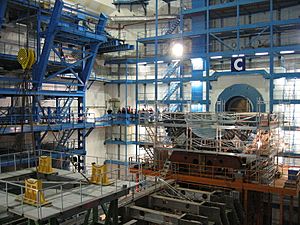ATLAS experiment facts for kids
ATLAS (which stands for A Toroidal LHC ApparatuS) is a giant science experiment. It is the largest experiment at the Large Hadron Collider (LHC). The LHC is the world's most powerful particle accelerator. It is located at CERN in Switzerland. Scientists use ATLAS to study tiny particles that make up everything in the universe. They hope to discover new things about how the universe works.
ATLAS is one of seven special machines called particle detectors at the LHC. These detectors help scientists see what happens when tiny particles crash into each other. The ATLAS experiment started working on September 10, 2008.
Contents
What is the ATLAS Experiment?
The ATLAS experiment is like a giant camera that takes pictures of particle crashes. These crashes happen inside the Large Hadron Collider (LHC). By studying these pictures, scientists learn about the smallest parts of matter. They want to understand the basic rules of the universe.
Where is ATLAS Located?
The ATLAS detector is built deep underground at CERN. CERN is a big science laboratory in Switzerland. It is a place where scientists from all over the world come to do research. The LHC is a huge ring that goes around under the ground.
How Big is ATLAS?
ATLAS is truly enormous! It is about 46 metres long and 25 metres wide. That's like a really big building! It weighs about 7,000 tonnes. That's heavier than many airplanes combined.
Who Works on ATLAS?
Many people work together on the ATLAS experiment. There are about 2,000 scientists and engineers involved. They come from 165 different research places in 35 countries. This makes ATLAS a huge international team effort. The project is currently led by Fabiola Gianotti.
What Does ATLAS Study?
ATLAS helps scientists study very heavy particles. These particles are too small and too fast to study with older machines. By looking at these particles, scientists hope to find new answers.
Searching for New Physics Theories
Scientists use ATLAS to look for new theories about particle physics. They want to go beyond what is called the Standard Model. The Standard Model explains many things about particles. But there are still some mysteries about the universe that it cannot explain. ATLAS helps scientists look for clues to solve these mysteries.
Images for kids
-
This is the TRT (Transition Radiation Tracker) central section. It was put together above ground and was collecting data from cosmic rays in September 2005.
-
September 2005: The main part of the ATLAS hadronic calorimeter, waiting to be moved inside the toroid magnets.
See also
 In Spanish: Experimento ATLAS para niños
In Spanish: Experimento ATLAS para niños










